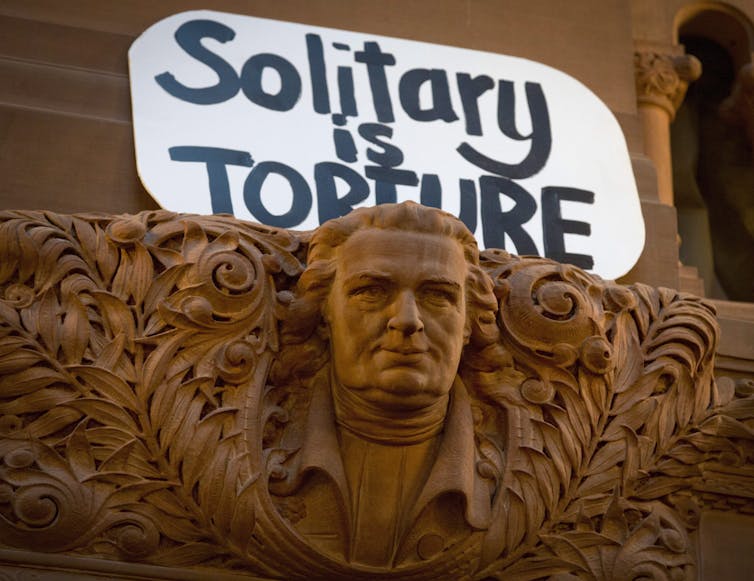In November 2019, structured intervention units (SIUs) officially replaced solitary confinement in Canada.
Prior to SIUs, solitary confinement operated through administrative segregation and disciplinary segregation. The new system claimed to add safeguards, mental health supports and provide prisoners with four hours outside their cells per day, including two hours of meaningful interaction. Despite being in place for over a year, recent data shows this system is a failure: one in 10 prisoners in SIUs experience torture.
It is crucial for corrections to respond to this human rights failure. As a socio-legal scholar and a critical policy analyst who studies carceral policy, we believe possible solutions include reducing the number of people confined in SIUs, hard caps on days permitted in SIUs, penalties and oversight. Our goal is to push for institutional accountability and transparency, which has long evaded corrections.
The current state of things
Criminologists Anthony Doob and Jane Sprott published a report in late February with data from the Correctional Service of Canada (CSC) that revealed solitary confinement is still happening and some practices amount to torture.
Read more: Solitary confinement by any other name is still torture
For those confined to SIUs, data revealed that 79 per cent of prisoners did not receive the required four hours outside of their cells per day for over half their stay. Additionally, 56 per cent of prisoners did not receive the required two hours of meaningful interaction outside of their cells per day for over half their stay. There is no evidence these measures have improved.
The data also revealed that 28 per cent of SIU stays constitute solitary confinement, which means prisoners spent 22 or more hours per day in their cell without meaningful interaction. Further, under the Mandela Rules, 9.9 per cent of SIU stays constitute torture, which means solitary confinement for more than 15 days. While Canada helped develop the United Nations Convention Against Torture, it has not meaningfully complied.

This treatment is dire for prisoners. One of us has done research with Indigenous former prisoners and their family members, both published and forthcoming. From this research, a former prisoner shares:
“I was exposed to solitary confinement for three days straight, and it affected me minimally, but it makes me imagine as someone who is cognitively sound and able, how does this affect everyone else, you know what I mean? How does it affect people who have intergenerational trauma and come from these places of disproportion? To get incarcerated and then to come back, damaged, and there’s no support?”
Trying to find solutions
In mid-2019, an external Implementation Advisory Panel was assembled to monitor and oversee SIUs. The panel disbanded in July 2020 due to lack of cooperation from CSC.
The most direct solution is to reduce and eventually eliminate the number of stays in SIUs. For now, however, prisons should place a hard cap on 15 days in solitary confinement and to ensure compliance, penalties should be given to managerial staff whose authority allows these practices to continue (e.g., suspensions without pay, disciplinary action).
CSC should be required to regularly release data to ensure rules are followed, and the SIU Implementation Advisory Committee should be reinstated and provided with the resources promised. Community members and organizations should also be permitted to enter prisons to monitor practices, and ensure overall prisoner well-being.
Community oversight
In 1991, in response to Elders’ increasing concerns over the high number of deaths in custody, Indigenous people in Queensland, Australia, launched Murri Watch, an Indigenous-led community organization offering culturally proficient services to individuals in the criminal justice system. In addition to the diversion and support programs offered on the outside, Murri Watch also intervenes and saves lives on the inside. The Cell Visitor Service program provides support to Aboriginal and Torres Strait Islander people detained in police custody.
Murri Watch members routinely visit prisoners and refer them to support services they can access while in custody. Their approach has helped prevent incidents of death and suicide, and minimized self-inflicted injuries among those in custody. In 2016 there were 2,818 cell visits, 1,443 messages relayed to families of prisoners and 388 referrals to other agencies.
In Canada, having community groups like Murri Watch routinely visit prisoners could better ensure transparency and accountability.
Through research on intergenerational criminalization, an Indigenous community member shares:
“Prison walls are as much as keeping people in as keeping us who are trying to help our people out. So the system needs to understand and make those relationships with our own people in meaningful ways. There is constant distrust of us as a people. We do have ideas, we do have solutions, we do have ways to help our own people. But barriers are constantly put up in our way to do that.”
Current rules are without teeth
Current rules prohibiting solitary confinement are without teeth and CSC continues to openly disregard the rules without penalty. Instead of centring human rights, CSC centres risk management, relying on SIUs as a risk management tool. Operating from a “tough on crime” vantage point, there is a lack of political willingness to transform corrections policy in a meaningful way.
From an interview with a community organization:
“We keep people informed of what’s happening in prisons, but we lack any authority. We lack any ability to keep Correctional Services Canada committed to their mandate of rehabilitation and reintegration. That’s the biggest gap.”
At the same time, community members, researchers and front-line workers want to help prisoners on the inside. Despite allowing torture to continue, Canada cares about its human rights image. Removing barriers to allow people to fix this problem, provides Canada an opportunity to salvage part of its image.

